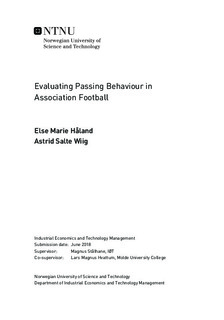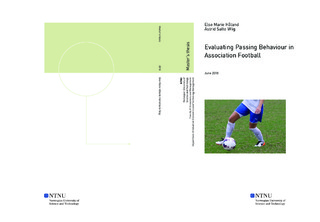| dc.description.abstract | Association football is the world's most popular sport, and there is a growing interest in the use of statistical methods to support decision-making within the sport to gain competitive advantages. In this thesis, the passing behaviour of football players is evaluated. The passing abilities of players, key players on teams and effectiveness of passing motifs in the Norwegian top division Eliteserien have been analysed through regression models and network analyses. The results from the different analyses build upon each other and are based around three aspects of a pass's success: accuracy, game overview and effectiveness. For the analyses, event-data from four consecutive seasons of Eliteserien (2014-2017) has been utilised.
Three generalised additive mixed models have been developed to assess players' passing abilities. Each model considers one of the three aspects of success, and the models were built on 565,720 observations in the data from the 2014-2016 seasons and tested on data from the 2017 season. The AIC criterion is used to determine whether a variable should be treated as a smooth term or a fixed effect, and Wald tests are performed for variable elimination.
In general, the signs of the coefficients and the shapes of the smooth functions in the resulting models make sense.
The models are used to identify the top ten pass makers in the 2017 season of Eliteserien, and the passing abilities of players over a period of time are determined by the ratio of the number of observed successful passes for a player over the models' expected number of successful passes for that player in the given time period.
%a player's observed successful passes over the model's expected number of successful passes for that player in the given time period.
The predicted probabilities obtained for passes in the passing ability models, together with the number of passes between players, were used as weights in network analyses. For each team and season in the data set, a network analysis was performed for each aspect of success to determine the key players in a team based on different network metrics. The closeness, betweenness and PageRank centrality measures and the Barrat clustering coefficient have been considered.
Results show that the player positions of the key players vary among the measures. Offensive players tend to be ranked higher on the closeness centrality and the PageRank measure for recipients, while defenders, with many easy passes in between each other, tend to be ranked higher on the PageRank measure for passers.
Rosenborg Ballklub players show some tendencies that differ from the general results across the teams in Eliteserien as defenders seem to be more involved in the offensive play.
Case studies give an indication that the team depends more upon players on the right-hand side in matches where they had a low ball possession.
To analyse what influences the effectiveness of four-sized passing motifs in Eliteserien, a generalised additive model was built using data from all four seasons. A total of 203,208 motifs were included in the analysis. Most of the explanatory variables in the model are based on the results from both the passing ability models and the network analyses. The findings indicate that the more compact motif types, i.e. where less unique players are involved, are less likely to lead to shots. However, there is no apparent relation between teams' internal usage of effective motif types and their end-of-season table position. | |

